How to Master Marketing Automation Best Practices

Marketing automation has revolutionized the way businesses connect with their audience. At Drop Cowboy, we’ve seen firsthand how implementing marketing automation best practices can transform customer engagement and drive growth.
In this post, we’ll explore the key strategies that can help you master marketing automation and take your campaigns to new heights. Whether you’re just starting out or looking to refine your existing approach, these insights will help you maximize the power of automation in your marketing efforts.
What Is Marketing Automation?
The Essence of Marketing Automation
Marketing automation transforms how businesses connect with their audience. It uses software to automate repetitive marketing tasks and workflows. This automation allows marketers to focus on strategy and creativity, rather than getting stuck in manual processes.
Key Components of Marketing Automation
A robust marketing automation strategy relies on several essential elements:
- Customer Relationship Management (CRM) System: This serves as the foundation, storing and managing customer data.
- Email Marketing Software: Integration with the CRM enables targeted, personalized emails based on customer behavior and preferences.
- Lead Scoring: This process assigns points to leads based on their interactions with your brand. It helps prioritize sales efforts and improves efficiency.
Benefits for Businesses of All Sizes
Marketing automation isn’t exclusive to large corporations. Small and medium-sized businesses can also reap significant benefits. A study by Nucleus Research found that marketing automation drives a 14.5% increase in sales productivity and a 12.2% reduction in marketing overhead.
Practical Applications
To implement marketing automation effectively, businesses should map out their customer journey. This process identifies key touchpoints where automation can enhance the customer experience. Examples include:
- Automated welcome email series for new subscribers
- Triggered follow-up messages when a customer abandons their shopping cart
- Personalized product recommendations based on browsing history
The Human Touch in Automation
The goal of marketing automation isn’t to eliminate the human element from marketing. Instead, it aims to use technology to deliver more relevant, timely, and personalized experiences to customers. When executed properly, it can lead to higher engagement, increased conversions, and ultimately, more revenue for your business.
Measuring Success
To gauge the effectiveness of your marketing automation efforts, track key performance indicators (KPIs) such as:
- Conversion rates
- Customer lifetime value
- Return on investment (ROI)
- Email open and click-through rates
These metrics provide valuable insights into the success of your automation strategies and highlight areas for improvement.
As we move forward, we’ll explore how to implement marketing automation best practices effectively. These strategies will help you maximize the power of automation in your marketing efforts and drive tangible results for your business. For instance, Zoho CRM offers integrations that can automate follow-ups, reminders, and announcements, enhancing your marketing automation capabilities.
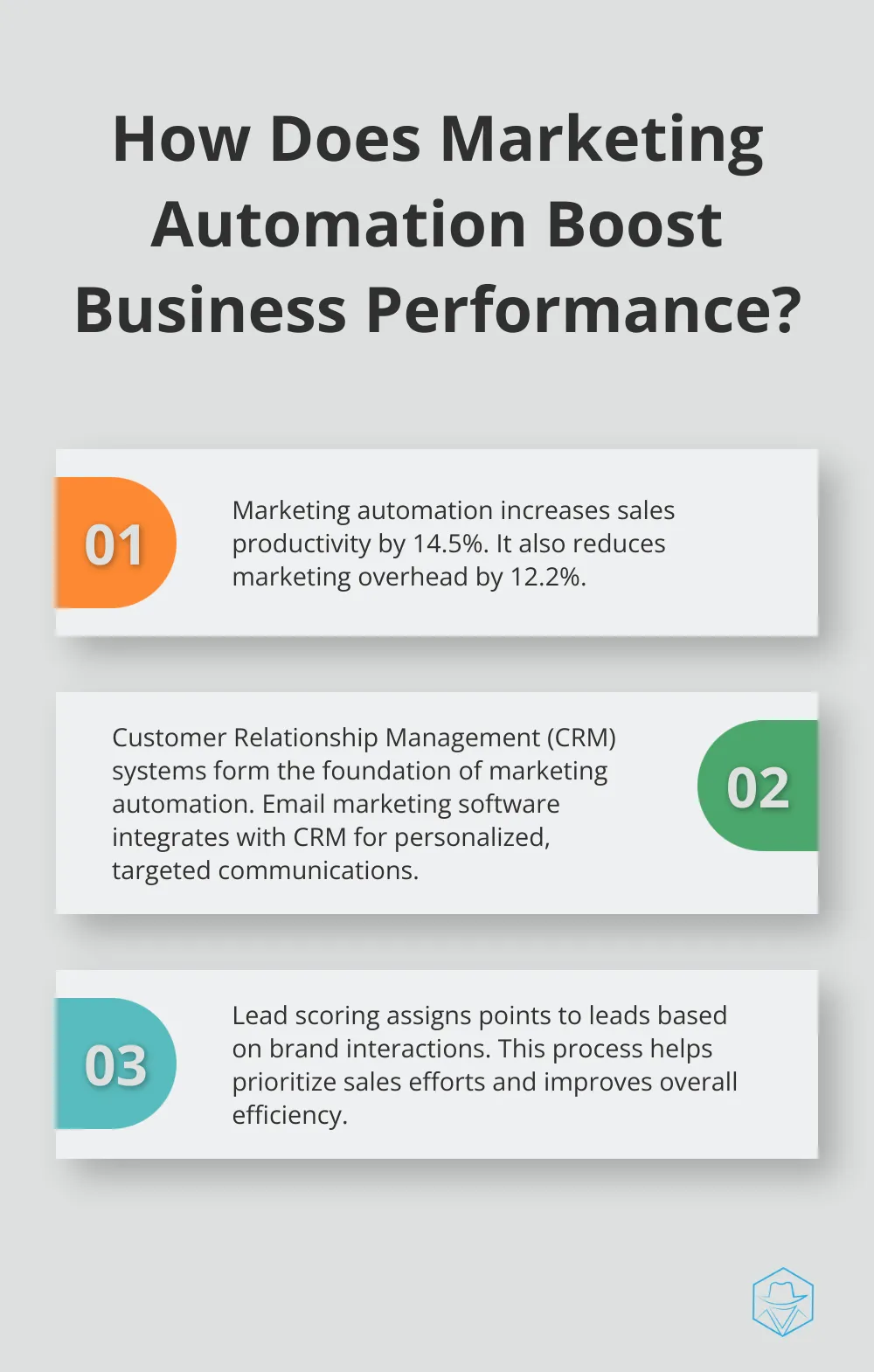
Mastering Audience Segmentation and Personalization
The Foundation of Segmentation
Segmentation forms the bedrock of effective marketing automation. It involves the division of your audience into distinct groups based on specific criteria. This practice allows you to tailor your messaging to resonate with each segment’s unique needs and preferences.
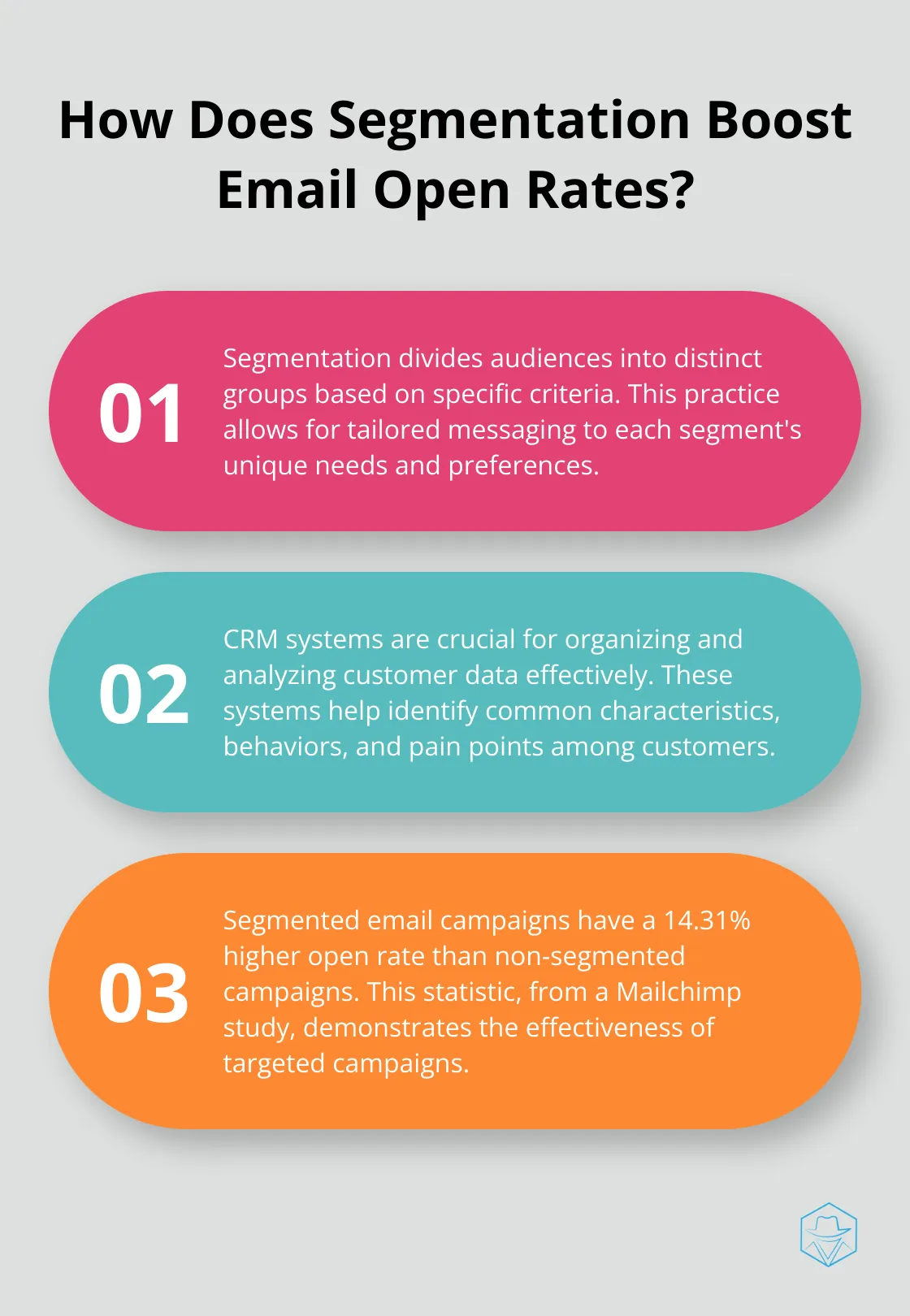
To start, analyze your customer data to identify common characteristics, behaviors, or pain points. These could include demographics, purchase history, engagement levels, or industry verticals. Customer relationship management (CRM) systems prove invaluable for organizing and analyzing this data effectively.
After identifying your segments, create targeted campaigns that speak directly to each group’s interests and challenges. This approach often leads to higher engagement rates. A study by Mailchimp found that segmented email campaigns have a 14.31% higher open rate than non-segmented campaigns.
Personalization Beyond Names
Personalization extends far beyond simply addressing a customer by name. It involves the delivery of content that’s truly relevant to each individual based on their preferences, behaviors, and stage in the customer journey.
Use dynamic content insertion to customize email content, landing pages, and even product recommendations based on user data. For example, an e-commerce site might showcase different products to a first-time visitor compared to a loyal customer.
Lead Scoring and Nurturing Optimization
Lead scoring plays a critical role in marketing automation. It helps prioritize leads based on their likelihood to convert. Assign point values to various actions and characteristics, such as website visits, content downloads, or job titles.
Implement a lead nurturing strategy that automatically moves leads through your sales funnel based on their score and behavior. This might involve sending educational content to early-stage leads and more product-focused information to those closer to making a purchase decision.
Multi-Channel Integration for Cohesive Experiences
Today’s customers interact with brands across multiple touchpoints. The integration of various channels into your marketing automation strategy ensures a cohesive customer experience.
Combine email marketing with SMS, social media, and even ringless voicemail for a comprehensive approach. This multi-channel strategy allows businesses to reach customers through their preferred communication channels, enhancing engagement and conversion rates.
The implementation of these best practices will set you on the path to creating more effective, targeted marketing campaigns that drive real results for your business. The next chapter will explore how to measure and optimize your marketing automation efforts, ensuring continuous improvement and maximum ROI.
How to Measure and Optimize Marketing Automation
Track the Right Metrics
Effective marketing automation relies on measuring the correct key performance indicators (KPIs). Focus on metrics that directly impact your bottom line, rather than vanity metrics. Conversion rates, customer acquisition costs, and customer lifetime value provide a clearer picture of your automation’s ROI. For example, if you use ringless voicemail campaigns, track the number of return calls and subsequent conversions to gauge effectiveness.
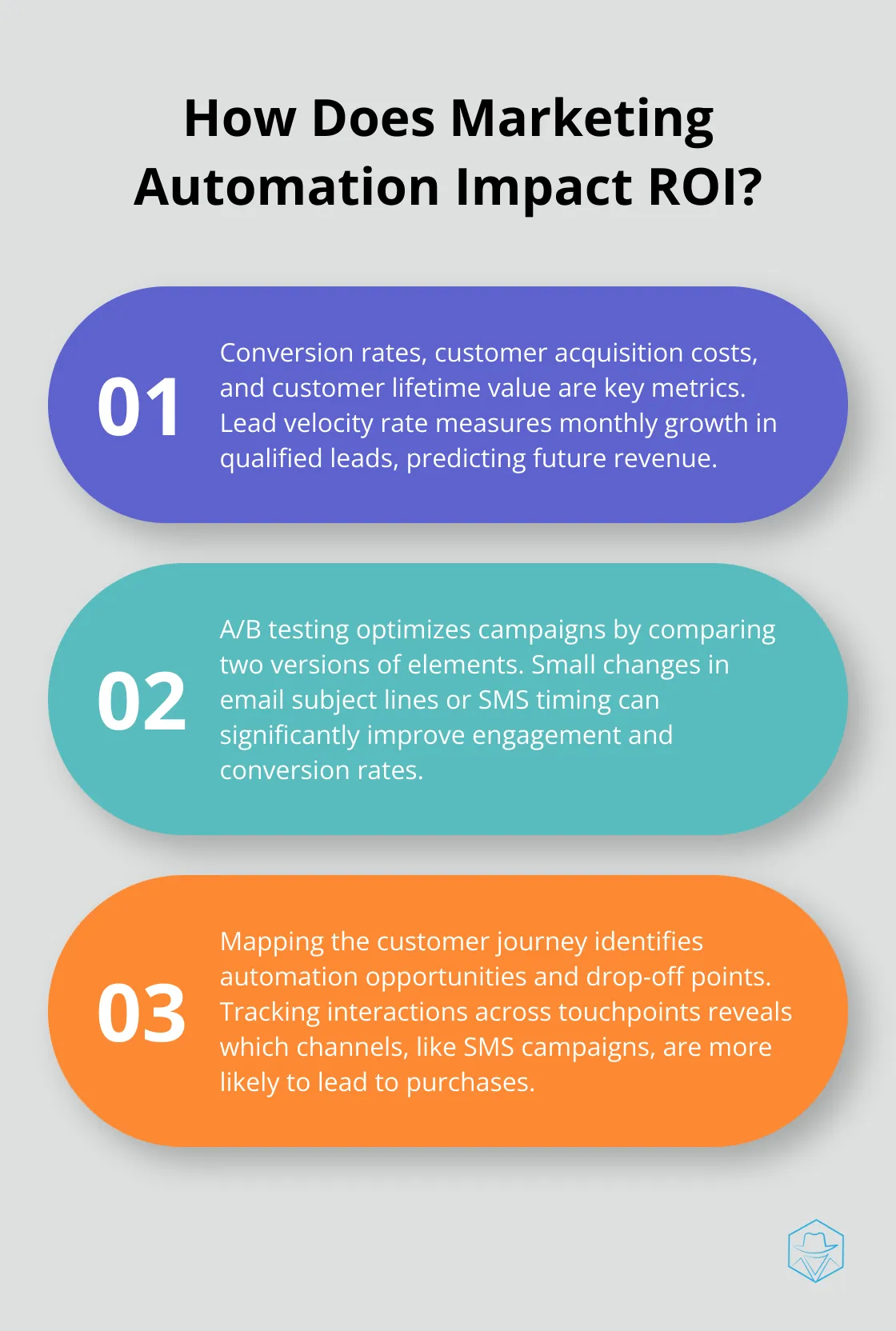
Lead velocity rate (LVR) is another important metric to consider. It measures the growth in qualified leads month-over-month, helping you predict future revenue and adjust your strategies accordingly.
Harness A/B Testing
A/B testing is a powerful tool for optimizing your marketing automation. Compare two versions of a campaign element to identify what resonates best with your audience. Start with small changes, such as different subject lines in your email campaigns or varied timing of your SMS messages. Even minor adjustments can lead to significant improvements in engagement and conversion rates.
Test one element at a time to ensure clear results. For instance, when using voice cloning technology (like Drop Cowboy’s Mimic AI™), you might test different tones or pacing in your voicemail messages to see which drives more responses.
Map the Customer Journey
Understanding your customer’s journey is essential for effective marketing automation. Use tools to track how customers interact with your brand across different touchpoints. This insight allows you to identify where automation can have the most impact.
You might discover that customers who engage with your SMS campaigns are more likely to make a purchase. With this knowledge, you can optimize your SMS strategy and integrate it more closely with other channels.
Pay attention to drop-off points in the customer journey. These areas often present opportunities for targeted automation to re-engage potential customers and guide them back into the sales funnel.
Refine with Data-Driven Decisions
The true power of marketing automation lies in its ability to generate valuable data. Use this data to continually refine your strategies. Look for patterns in customer behavior and adjust your automation workflows accordingly.
If you notice that certain types of content consistently lead to higher engagement, create more of that content and incorporate it into your automated campaigns. Similarly, if particular segments of your audience respond better to specific messaging, use that insight to further personalize your communications.
Make bold changes based on data when necessary. If the numbers show that a particular strategy isn’t working, pivot quickly. The agility to adapt based on real-time data is one of the greatest advantages of marketing automation.
Final Thoughts
Marketing automation has transformed how businesses connect with customers and streamline operations. Companies that implement marketing automation best practices can significantly improve their marketing efforts, boost efficiency, and drive growth. At Drop Cowboy, we understand the power of these practices in driving business success. Our platform offers innovative features like ringless voicemail and SMS integration, coupled with advanced AI capabilities.
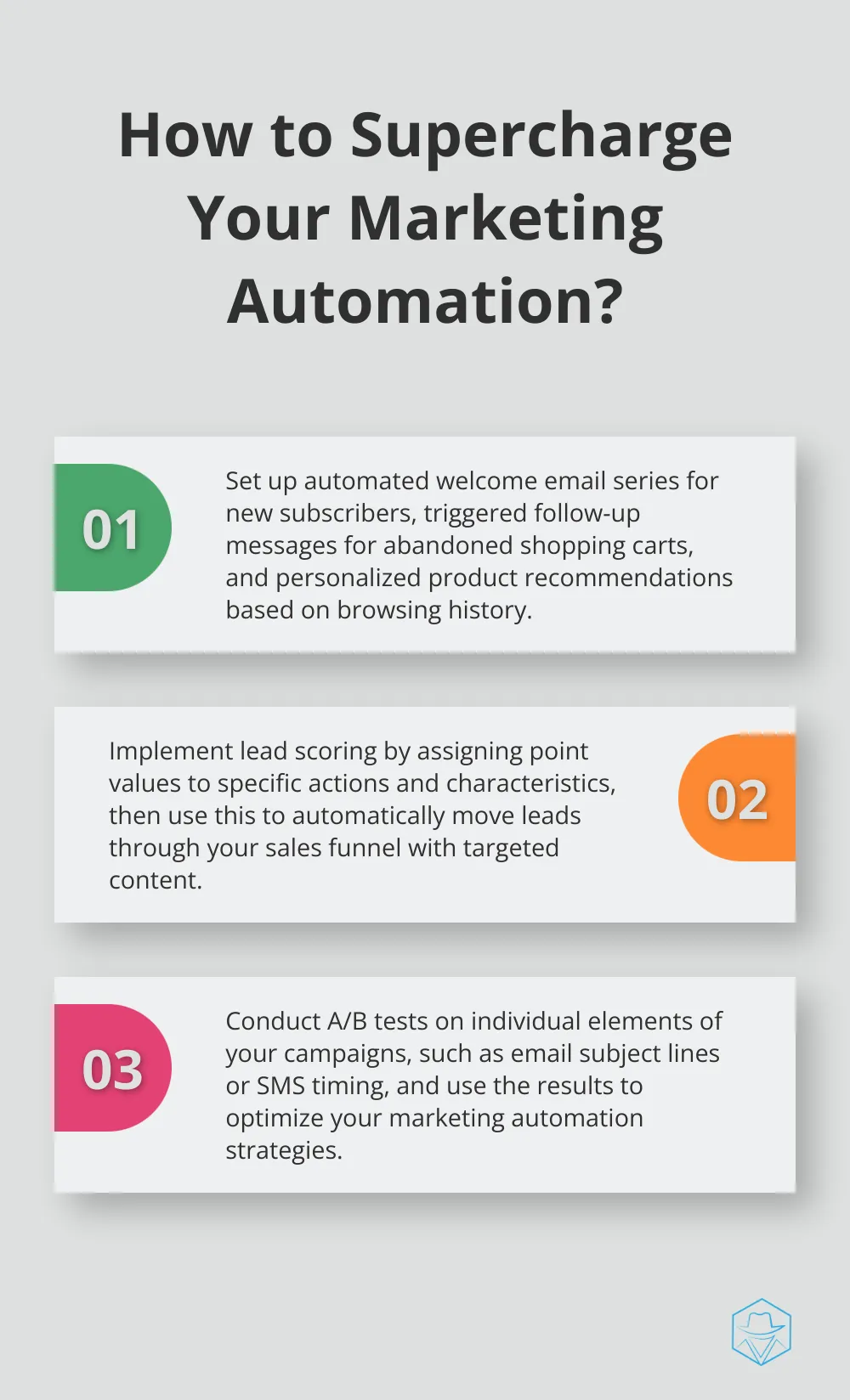
The future of marketing automation will involve artificial intelligence and machine learning, enabling more sophisticated personalization and predictive analytics. Voice-activated technologies and chatbots will enhance customer interactions, providing seamless experiences across various touchpoints. To start or improve your current strategy, assess your processes and identify areas where automation can have the most impact.
Invest in a robust CRM system to centralize your customer data and choose marketing automation tools that integrate well with your existing tech stack. Prioritize data quality and compliance to ensure the effectiveness and legality of your campaigns. The journey to master marketing automation may seem challenging, but the rewards in improved customer relationships, increased efficiency, and business growth make it worthwhile.
blog-dropcowboy-com
Related posts
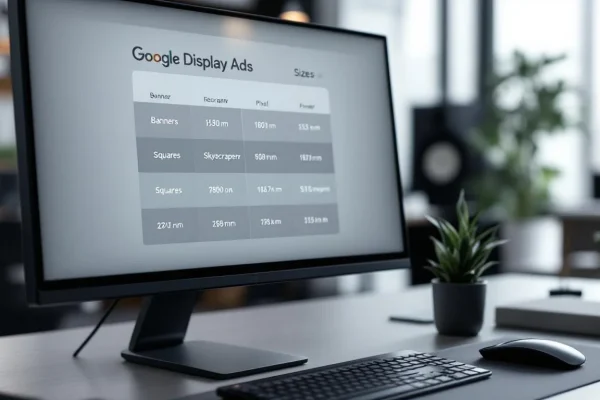
June 11, 2025
Google Display Ad Sizes: Which Formats Work Best?
Explore which Google Ads display size boosts engagement most effectively in your campaigns for optimal advertising results.

August 4, 2025
When you call someone and it goes straight to voicemail
Uncover why calls go straight to voicemail and learn effective solutions. Find out what to do when you call someone and it goes straight to voicemail.

June 12, 2025
How to Use Sinch Voice for Seamless Communication
Enhance your communication effortlessly with Sinch Voice. Discover practical tips to integrate its features for smooth and efficient interactions.

August 4, 2025
Why does a call go straight to voicemail
Understand why a call goes straight to voicemail. Learn common causes like network issues or phone settings and how to fix them.
![Perfect Your SMS Timing for Maximum Open Rates [Guide]](/blog/wp-content/uploads/emplibot/sms-timing-optimization-hero-1756512408-600x400.webp)
September 3, 2025
Perfect Your SMS Timing for Maximum Open Rates [Guide]
Boost engagement by mastering SMS timing optimization. Learn actionable tips to enhance open rates and elevate your messaging strategy.
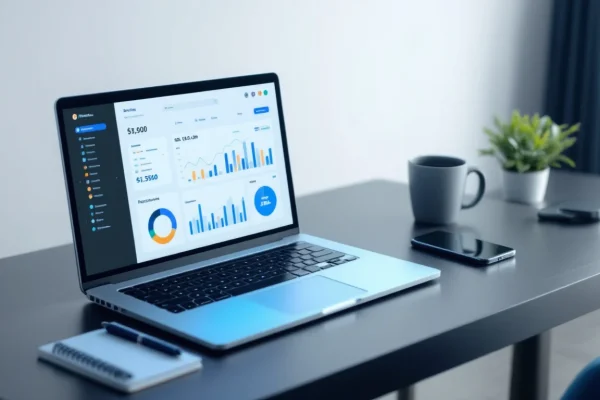
May 23, 2025
How to Navigate the World of HES Fintech
Explore HES Fintech solutions and tips to efficiently manage your financial operations and stay ahead in the dynamic fintech landscape.